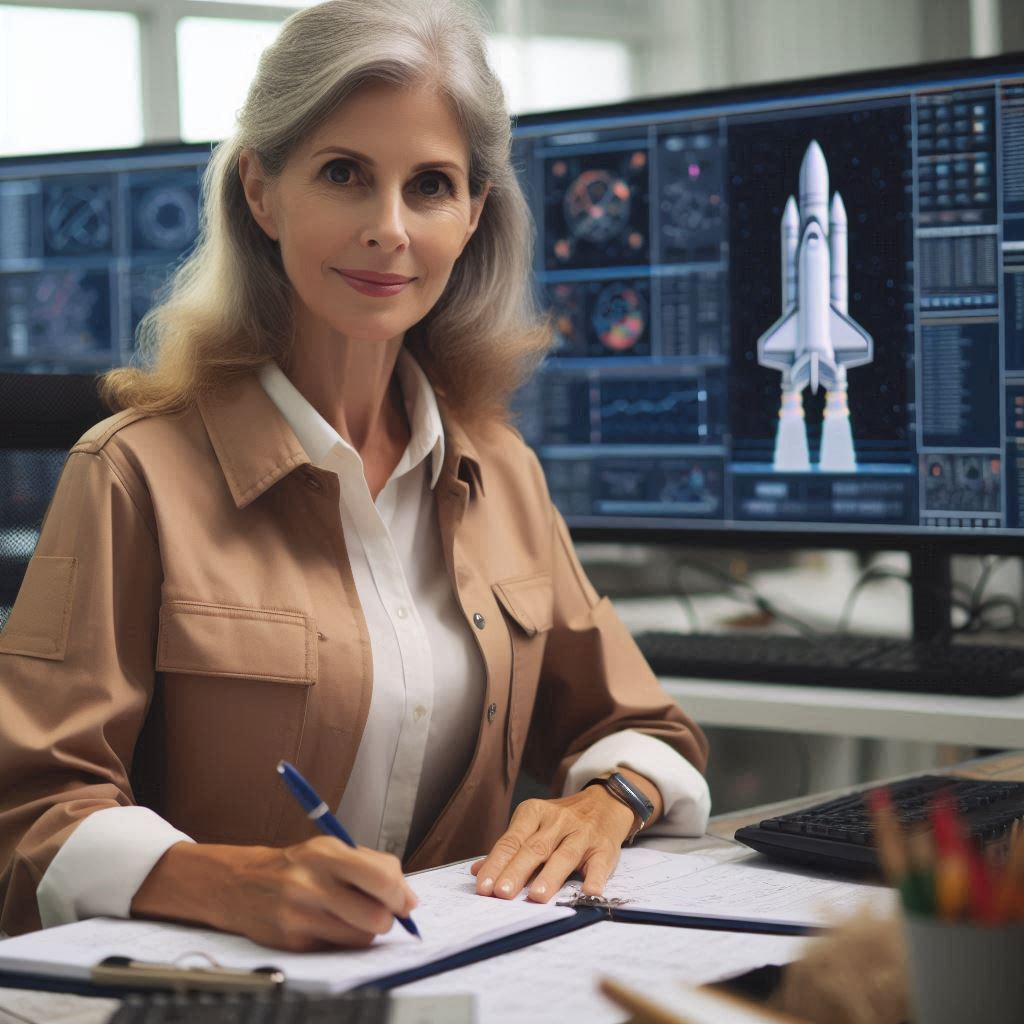Introduction
Aerospace Engineering R D play a pivotal role in aerospace engineering.
They are the driving force behind innovation and the advancement of technology in the field.
Without R&D, the aerospace industry would stagnate, unable to push the boundaries of what is possible in air and space travel.
R&D efforts are essential for creating new technologies, materials, and designs that improve the performance and safety of aircraft and spacecraft.
Through rigorous research, engineers develop cutting-edge solutions that address complex challenges.
This process involves extensive experimentation, testing, and refinement to ensure that new innovations meet stringent industry standards.
R&D also enables the exploration of revolutionary ideas that might not yet be feasible.
This forward-thinking approach helps identify potential breakthroughs and paves the way for future innovations.
Continuous investment in R&D ensures that the aerospace industry remains dynamic and capable of achieving remarkable progress.
By fostering a culture of research and innovation, R&D helps aerospace engineers stay at the forefront of technological advancements.
It allows them to explore new possibilities, refine existing technologies, and develop more efficient propulsion systems, lighter and stronger materials, and advanced avionics.
These advancements result in aircraft that are safer, more reliable, and more fuel-efficient.
Read: Iconic US Buildings and the Architects Behind Them.
The role of R&D in aerospace engineering
How R&D Plays a Crucial Role in Pushing the Boundaries of Technological Advancements in Aerospace
Research and development (R&D) are vital for pushing the boundaries of technological advancements in aerospace engineering.
R&D efforts drive innovation and enable engineers to explore new possibilities.
These activities are essential for addressing complex challenges and advancing the field.
R&D allows aerospace engineers to test theories, experiment with new concepts, and refine existing technologies.
This process leads to the development of cutting-edge solutions that improve the performance and safety of aircraft and spacecraft.
Engineers rely on R&D to stay at the forefront of technological advancements and maintain competitiveness in the industry.
Through R&D, engineers can explore revolutionary ideas that may not yet be feasible.
This forward-thinking approach helps identify potential breakthroughs and paves the way for future innovations.
Continuous investment in R&D ensures that the aerospace industry remains dynamic and capable of achieving remarkable progress.
Impact of R&D in Developing New Materials, Designs, and Technologies for Aircraft
R&D has a significant impact on developing new materials, designs, and technologies for aircraft.
Engineers continuously seek materials that offer better performance, durability, and weight reduction.
Advanced materials like carbon fiber composites have revolutionized aircraft design, making planes lighter and more fuel-efficient.
Developing new designs is another crucial aspect of aerospace R&D.
Engineers use sophisticated modeling and simulation tools to create innovative aircraft configurations.
These designs undergo rigorous testing and refinement to ensure optimal performance and safety.
R&D efforts lead to the creation of more aerodynamic and efficient aircraft that meet stringent industry standards.
Technological advancements driven by R&D also play a critical role in aerospace engineering.
The development of advanced propulsion systems, such as electric and hybrid engines, is a result of extensive research efforts.
These technologies offer significant benefits, including reduced emissions and improved fuel efficiency.
R&D in avionics and control systems has led to the development of sophisticated navigation and communication technologies.
These advancements enhance the safety and reliability of aircraft operations.
Engineers continuously explore ways to improve these systems, making air travel safer and more efficient.
R&D also contributes to the development of innovative manufacturing processes.
Techniques like additive manufacturing, or 3D printing, have transformed how aircraft components are produced.
These methods allow for more complex designs, reduced material waste, and faster production times.
Read: Post-Pandemic Design Trends: US Architects Adapt
Advantages of investing in R&D in aerospace engineering
Benefits of investing in R&D for aerospace companies
Investing in Research and Development (R&D) in the field of aerospace engineering is crucial for companies looking to stay competitive in a rapidly evolving industry.
By dedicating resources to R&D efforts, aerospace companies can reap a multitude of benefits that ultimately lead to innovation and success.
One significant advantage of investing in R&D is the ability to stay ahead of the competition.
In an industry as dynamic as aerospace engineering, companies must continuously push the boundaries of innovation to differentiate themselves from rivals.
By investing in R&D, companies can develop cutting-edge technologies and products that set them apart in the market.
How R&D can lead to cost reduction, improved safety, and enhanced performance of aircraft
R&D efforts also play a crucial role in driving cost reduction for aerospace companies.
Through research and experimentation, companies can discover more efficient manufacturing processes, materials, and technologies that ultimately lead to cost savings.
By investing in R&D, companies can optimize their operations and make their products more affordable for consumers.
Furthermore, investing in R&D can significantly improve the safety and reliability of aircraft.
By conducting thorough research and testing, aerospace companies can identify potential risks and vulnerabilities in their designs, leading to enhanced safety measures and protocols.
Additionally, R&D efforts can lead to the development of advanced systems and technologies that enhance the overall performance of aircraft.
Another key advantage of investing in R&D is the ability to drive innovation and creativity within the aerospace industry.
By dedicating resources to research and experimentation, companies can foster a culture of innovation that inspires employees to think outside the box and develop groundbreaking technologies.
This culture of innovation can lead to the creation of revolutionary products and solutions that push the industry forward.
In general, investing in R&D in aerospace engineering is essential for companies looking to thrive in a competitive market.
By exploring the benefits of R&D, such as cost reduction, improved safety, and enhanced performance of aircraft, companies can drive innovation, stay ahead of the competition, and ultimately achieve long-term success in the aerospace industry.
Read: How to Become a Civil Rights Advocate
Collaboration and partnerships in R&D
Importance Of Collaboration Between Aerospace Companies, Research Institutions, and Government Agencies
Aerospace companies often collaborate with research institutions and government agencies to conduct cutting-edge R&D.
This collaboration brings together diverse perspectives and expertise, fostering innovative solutions.
Research institutions provide theoretical knowledge and experimental facilities, while aerospace companies offer practical insights and real-world applications.
Government agencies contribute funding, regulatory support, and strategic guidance.
These partnerships ensure that R&D efforts align with industry needs and regulatory standards.
By working together, these entities can address complex challenges, develop new technologies, and enhance the safety and efficiency of aerospace systems.
Collaboration also ensures that innovations are rapidly adopted and integrated into commercial and defense applications.
Transform Your Career Today
Unlock a personalized career strategy that drives real results. Get tailored advice and a roadmap designed just for you.
Start NowPooling Resources, Expertise, and Knowledge
Partnerships between aerospace companies, research institutions, and government agencies enable the pooling of resources.
R&D projects often require significant financial investment, advanced equipment, and skilled personnel.
By sharing these resources, partners can undertake more ambitious projects and achieve better results.
Pooling expertise is equally important.
Aerospace engineering requires knowledge from various disciplines, including materials science, mechanical engineering, and computer science.
Collaborative R&D brings together experts from these fields, fostering interdisciplinary innovation.
This approach leads to more comprehensive and robust solutions.
Knowledge sharing is another critical benefit of collaboration.
Each partner brings unique insights and experiences to the table.
By sharing knowledge, partners can avoid duplication of efforts, learn from each other’s successes and failures, and accelerate the R&D process.
This collective intelligence drives innovation and helps the industry stay ahead of technological trends.
Accelerating Innovation Through Partnerships
Collaborative R&D significantly accelerates innovation in aerospace engineering.
By combining resources, expertise, and knowledge, partners can develop and test new technologies more quickly.
This acceleration is crucial in a competitive industry where technological advancements can provide significant advantages.
Partnerships also facilitate the commercialization of new technologies.
Aerospace companies can leverage the findings from research institutions and government-supported projects to bring innovative products to market.
This collaboration reduces the time from concept to deployment, ensuring that cutting-edge technologies benefit the industry sooner.
Furthermore, collaborative R&D enhances the ability to tackle complex challenges.
Issues such as reducing environmental impact, improving fuel efficiency, and enhancing safety require multifaceted solutions.
By working together, partners can address these challenges from multiple angles, leading to more effective and sustainable outcomes.
R&D in aerospace engineering thrives on collaboration between aerospace companies, research institutions, and government agencies.
These partnerships pool resources, expertise, and knowledge, driving innovation and accelerating technological advancements.
By fostering a collaborative approach, the aerospace industry can continue to push the boundaries of what is possible, ensuring a future of safer, more efficient, and more advanced aerospace systems.
Future trends and challenges in aerospace R&D
Future Trends in Aerospace R&D
As technology continues to advance, the aerospace industry is experiencing a shift towards more sustainable and efficient modes of transportation. One major trend in aerospace R&D is the development of electric aircraft.
These aircraft use electric propulsion systems, which are cleaner and quieter than traditional combustion engines.
Electric aircraft have the potential to reduce carbon emissions and noise pollution, making them an attractive option for the future of aviation.
Another trend in aerospace R&D is the rise of autonomous drones.
These unmanned aerial vehicles (UAVs) are being developed for a variety of uses, including surveillance, delivery services, and search and rescue missions.
Autonomous drones have the advantage of being able to operate without human intervention, making them valuable tools for industries such as agriculture, construction, and emergency response.
Challenges in Aerospace R&D
Despite the exciting developments in aerospace R&D, the industry faces several challenges that must be addressed in order to continue progressing.
One major challenge is funding constraints.
Research and development in the aerospace industry require significant financial investment, and securing funding can be a lengthy and competitive process.
Without adequate funding, progress in aerospace R&D may be slow or even stalled.
Another challenge in aerospace R&D is regulatory barriers.
The aerospace industry is heavily regulated to ensure safety and security, which can create obstacles for researchers and developers.
Navigating the complex regulatory landscape requires time and expertise, and regulatory changes can impact the direction and pace of R&D projects.
Overcoming regulatory barriers is crucial for the aerospace industry to innovate and adapt to new technologies.
Generally, while there are exciting future trends on the horizon for aerospace R&D, it’s essential to acknowledge and address the challenges that the industry faces.
By finding solutions to funding constraints and regulatory barriers, the aerospace industry can continue to push the boundaries of innovation and create a more sustainable and efficient future for aviation.
Read: The Intersection: Architecture & Tech in Modern USA.

Learn More: Roles and Duties of Geological Technicians Explained
Delve into the Subject: Impact of Technology on Drafter Profession
Case studies of successful R&D projects in aerospace engineering
Successful R&D Projects Leading to Groundbreaking Innovations
Research and development (R&D) in aerospace engineering has resulted in numerous groundbreaking innovations.
One prime example is the development of the Boeing 787 Dreamliner.
This aircraft introduced advanced composite materials, which reduced weight and increased fuel efficiency.
The Dreamliner‘s success highlights the impact of dedicated R&D efforts in pushing technological boundaries.
Another significant R&D achievement is the Mars Rover program by NASA.
The rovers, including Curiosity and Perseverance, represent years of intensive research and testing.
These projects have advanced our understanding of Mars, providing valuable data on the planet‘s geology and potential for life.
The rovers‘ sophisticated engineering, including autonomous navigation and robust scientific instruments, showcases the importance of continuous R&D in achieving space exploration milestones.
SpaceX‘s development of the Falcon 9 rocket is another notable R&D triumph.
The rocket‘s reusability feature has revolutionized space travel, significantly reducing launch costs. SpaceX achieved this by focusing on innovative landing technologies and materials engineering.
The Falcon 9‘s success exemplifies how targeted R&D can lead to practical and economic advancements in aerospace.
Transforming the Industry and Benefiting Society
These R&D projects have profoundly transformed the aerospace industry and provided broad societal benefits.
The Boeing 787 Dreamliner, for example, has revolutionized commercial aviation.
Its fuel efficiency reduces operational costs for airlines and lowers carbon emissions.
This environmental benefit is crucial in addressing global climate change concerns.
NASA‘s Mars Rover missions have expanded human knowledge and inspired further exploration.
The data collected by the rovers aids scientists in understanding planetary processes, which could inform future human missions to Mars.
The technological advancements from these missions also trickle down to other sectors, including robotics and artificial intelligence, fostering innovation beyond aerospace.
Transform Your Career Today
Unlock a personalized career strategy that drives real results. Get tailored advice and a roadmap designed just for you.
Start NowSpaceX‘s Falcon 9 rocket has democratized access to space by lowering launch costs.
This affordability enables more countries and private companies to participate in space exploration and satellite deployment.
The increased satellite presence enhances global communications, weather forecasting, and Earth observation capabilities, benefiting various aspects of modern life.
Furthermore, these successful R&D projects demonstrate the importance of investing in innovation.
They encourage other aerospace companies to pursue ambitious projects, fostering a competitive and dynamic industry.
This competitive environment drives continuous improvement, ensuring that aerospace engineering remains at the forefront of technological advancement.
In review, R&D in aerospace engineering is essential for driving innovation and industry transformation.
Successful projects like the Boeing 787 Dreamliner, NASA‘s Mars Rovers, and SpaceX‘s Falcon 9 rocket exemplify the profound impact of dedicated research and development efforts.
These projects have not only revolutionized the aerospace industry but also provided significant societal benefits, highlighting the critical role of R&D in advancing technology and improving quality of life.
The importance of government support for R&D in aerospace engineering
Role of Government Funding and Policies in Supporting R&D
Government funding and policies play a crucial role in supporting R&D initiatives in the aerospace industry.
Governments allocate substantial budgets to aerospace research to ensure technological advancements and maintain competitive edges.
This funding supports basic and applied research, leading to new discoveries and innovations.
Policies that incentivize R&D investment, such as tax credits and grants, encourage private sector participation.
These policies help create a robust ecosystem where public and private entities collaborate to push the boundaries of aerospace technology.
Government agencies like NASA, the European Space Agency (ESA), and the Defense Advanced Research Projects Agency (DARPA) provide critical funding for aerospace R&D.
These agencies set strategic priorities and fund projects that align with national interests.
By directing resources to high-impact areas, governments ensure that R&D efforts address the most pressing challenges in aerospace engineering.
Funding also supports academic institutions and research labs, fostering a culture of innovation and scientific inquiry.
Government Support Fostering Innovation
Government support is essential for fostering innovation in aerospace engineering.
With adequate funding, researchers can explore new materials, propulsion systems, and avionics technologies.
These innovations improve the performance, safety, and efficiency of aircraft and spacecraft.
Government-funded projects often lead to breakthrough technologies that revolutionize the aerospace industry.
For instance, NASA‘s research has contributed to advancements in aerodynamics, thermal protection systems, and autonomous flight.
Collaboration between government agencies and private companies accelerates innovation.
Public-private partnerships leverage the strengths of both sectors, combining resources, expertise, and risk-sharing.
These collaborations drive the development of cutting-edge technologies and bring them to market faster.
Government support also enables long-term research projects that may be too risky or expensive for private companies to undertake alone.
Creating Job Opportunities and Boosting Economic Growth
Government investment in aerospace R&D creates job opportunities and boosts economic growth.
Research projects require skilled scientists, engineers, and technicians, leading to the creation of high-quality jobs.
These positions contribute to the development of a highly skilled workforce, essential for maintaining a competitive aerospace sector.
Moreover, the aerospace industry‘s growth stimulates job creation in related sectors, such as manufacturing, logistics, and information technology.
Economic growth is another significant benefit of government-supported R&D in aerospace.
Innovations resulting from R&D efforts lead to the development of new products and services.
These advancements increase the competitiveness of aerospace companies in the global market, driving exports and economic activity.
Additionally, the commercialization of new technologies can create entirely new markets and industries, further boosting economic growth.
Government support for aerospace R&D also enhances national security.
Advanced aerospace technologies improve defense capabilities and ensure military superiority.
By investing in R&D, governments ensure that their aerospace sectors remain at the forefront of technological advancements.
Government funding and policies are vital for supporting R&D initiatives in the aerospace industry.
These efforts foster innovation, create job opportunities, and drive economic growth.
By investing in R&D, governments ensure that the aerospace sector remains dynamic, competitive, and capable of addressing future challenges.
Public support for R&D not only advances technology but also strengthens the overall economy and national security.
Explore Further: Work-Life Balance Tips for Engineering Technicians
Conclusion
Research and development (R&D) play a crucial role in advancing aerospace engineering.
By pushing the boundaries of innovation, R&D drives advancements in aircraft design, materials, and technologies.
Furthermore, the importance of R&D in aerospace engineering cannot be overstated.
It allows for the development of cutting-edge solutions to complex challenges, leading to safer and more efficient aircraft.
Investing in R&D is essential to stay competitive in the aerospace industry.
Companies that prioritize R&D are more likely to pioneer breakthrough technologies and stay ahead of the curve.
Continuous investment in R&D is vital to driving future advancements in aerospace technology.
It ensures that the industry remains at the forefront of innovation, meeting the demands of an ever-evolving market.
In summary, R&D in aerospace engineering is a driving force behind progress in the industry.
It fuels creativity, fosters collaboration, and ultimately shapes the future of aviation.
Continued investment in R&D is crucial to secure a prosperous and sustainable future for aerospace technology.




